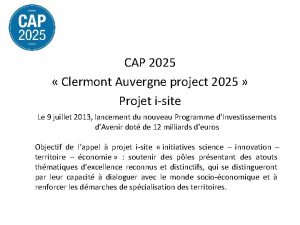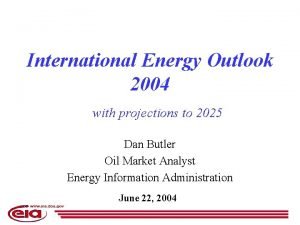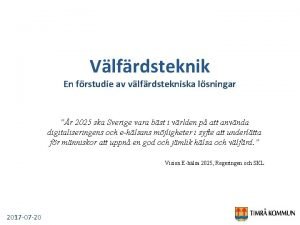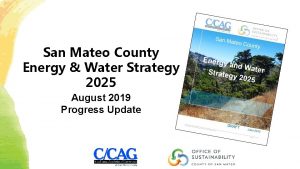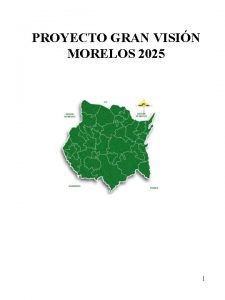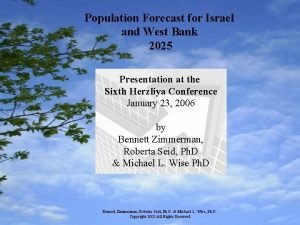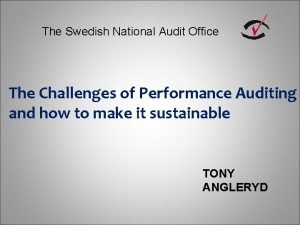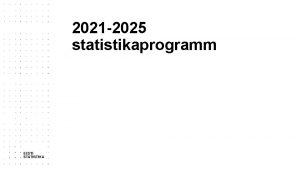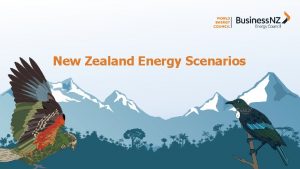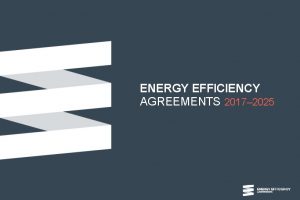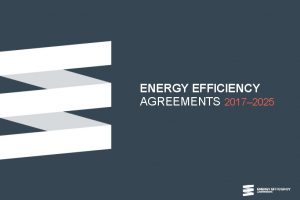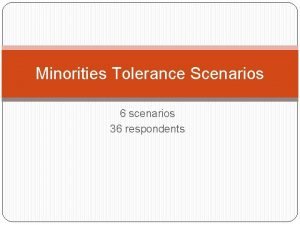Energy Scenarios 2025 National office of Energy Scenarios





























- Slides: 29

Energy Scenarios 2025 National office of Energy Scenarios and Project Assessment Undersecretariat of Energy Scenarios and Project Assessment Secretariat of Strategic Energy Planning December 2016

About this presentation The outcomes of the analysis shown in these slides, which are associated to four scenarios deriving from the combination of different demand, investment, price and productivity assumptions, do not intend to be predictive, but they are projections of what it may occur according to the combination of such assumptions. Due to the dynamic nature of an energy sector which is undergoing a regulatory, economic and institutional normalization process, such scenarios are dynamic. For this reason, the outcomes of the scenarios might change significantly in subsequent editions, in line with the evolution of the national and international energy reality, with the development of the different economic sectors and with changing boundary conditions – for example the changes in the dynamic of international prices, the evolution of climate change agreements or the occurrence of events of technological or political disruption -, which would lead to the inclusion or the adjustment of the used assumptions. Additionally, it should be highlighted that the Ministry of Energy and Mining does not assign different probabilities of occurrence to the modeled scenarios , instead, it impartially presents the outcomes for the analysis of the population. This is part of the beginning of a shared vision building process of the Argentine society in order to build a sustainable energy future. By virtue of this ministry, the National Executive Power promotes the creation of spaces for dialogue, as well as a greater transparency by making more and better information available, and also, clearly contributes to strengthen the abilities of the State to suitably reflect, in its future editions, scenarios that show goal-related outcomes. 2

Outlook 2025 - Charts index • International context • Definition of cases and assumed basis • Demand forecasting and supply alternatives • Outcomes of the supply/demand balance • Economic and environmental impact 3

Definition of cases and assumed basis

Methodology ENERGY INFORMATION SYSTEM POLICIES TECHNOLOGIES ENERGY SCENARIOS INTERNATIONAL AND REGIONAL ENERGY SCENARIOS SOCIO-ECONOMIC SCENARIOS MINISTRY OF TREASURY AND PUBLIC FINANCES ENVIRONMENT MESSAGE LEAP - DEMAND OSCAR – MARGO MODEL DEMAND SCENARIOS ECONOMETRIC MODELS SUPPLY SCENARIOS INTERACTIONADJUSTMENTS REFINERY MODEL HYDROCARBONS PRODUCTION MODELS TIMES - MARKAL ENVIRONMENT AL LEAP ENERGY BALANCES ECONOMIC AND FINANCIAL 5

Scenarios set-up 2 Demand Scenarios Trend Scenario 2 Supply Scenarios Efficient Scenario Base Scenario High demand + Low production of hydrocarbons Efficient demand + Low production of hydrocarbons Scenario + Investment High demand + High production of hydrocarbons Efficient demand + High production of hydrocarbons • Two demand scenarios which include the impact of energy efficiency and energy saving • Two scenarios of hydrocarbons supply which are defined according to prices, investment levels and improvements in productivity and in efficiency • If combined, 4 scenarios may be obtained. 6

The international context marked by major changes Demand growth with less energy intensity • • Higher growh in developing countries, including China, India and Latin America Impact of the incorporation of electric vehicles and other technoogies Paris Agreement on climate change will generate important changes in energy policies • • 2/3 of the greenhouse gas emissions are produced by the energy sector Commitment to reduce emissions to limit global warming to 2°C New technologies allow for the reduction of fossil fuel consumption and for the generation of clean electricity • Competitiveness of non-traditional renewable sources Uncertainty in oil and natural gas markets • • Lower growth in oil demand reduced price vs previous scenarios Global market for natural gas at a stable and lower price 7

International context Region OECD Non-OECD Asia (non-OECD) Latin America World GDP(% y. y. ) 2014 -2020 Pop. (% y. y. ) 2014 -2025 2. 00% 4. 60% 6. 10% 0. 80% 3. 50% 0. 5% 1. 2% 0. 8% 0. 9% 1. 0% Source: International Energy Agency - World Energy Outlook 2015 • The economic growth continues to be the main driver of energy demand. The population grows from 7. 1 trillion to almost 8 trillion people. • 1. 2% 10. 1% 2. 4% 4. 8% 10. 6% 29. 0% 2. 9% 26. 5% 2. 7% 6. 0% 2025 2013 Within the scenario of new policies of the IEA, there is a coal and oil downturn, and an increase of natural gas, nuclear and renewables. 21. 4% 22. 1% 31. 1% 29. 3% 8 Source: International Energy Agency - World Energy Outlook 2015

Socio-economic scenario assumption GDP Annual variation 3. 6% 3. 5% 4. 0% 3. 3% 3. 4% Population 2025: 47. 5 MM 2. 4% 2. 0% Growth 2015 – 2025: 2. 9 % y. y. 1. 0% 0. 0% 2015 2016 2017 2018 2019 2020 2021 2022 2023 2024 -1. 0% -2. 0% Motor vehicles on the road 2025 2015: 240 vehicles per 1, 000 people. 2025: 305 vehicles per 1, 000 people. -1. 4% 2040: 400 vehicles per 1, 000 people. Price scenarios Natural gas penetration US Energy Information Administration (EIA) Short Term Energy Outlook, July 2016 & Annual Energy Outlook 2016. 2015: 62 % of households. 2025: 68 % of households. 9

Basis for the calculation of energy efficiency saving Measures for electric power (15% saving) • • • Efficient appliances Switching light bulbs in the residential sector Setting of air conditioners to around 25 ° Street and public lighting Efficient engines Energy management systems Energy diagnosios Co-generation Variable speed drives Measures for natural gas (2. 3% saving) • Heat pumps • Boilers and water heaters • Furnaces Measures in transport - gasoil (10. 6% saving) • Efficient road transport 10

Demand forecasting and production alternatives

Energy final consumption 80, 000 1, 200, 000 +2, 6 % a. a. 60, 000 1, 000 +2 % a. a. +2, 6 % a. a. 800, 000 ktep 50, 000 +2, 9 % a. a. 40, 000 600, 000 30, 000 400, 000 +2, 6 % a. a. 20, 000 MM$04 70, 000 200, 000 10, 000 - 1993 1995 1997 1999 2001 2003 2005 2007 2009 Tendencial TWh 2015 Eficiente 2013 2015 2017 2019 2021 2023 2025 PBI MM$04 MMm 3 132 2015 192 3, 8 % a. a. 2025 Trend 2025 Efficnet 2011 163 2, 1% a. a. 2025 Trend 2025 Efficient Saving= 15% 27, 500 34, 100 2, 2 % a. a. 33, 300 1, 9% a. a. Saving = 2, 3% 12 NOTE: Natural gas demand does not include RTP CERRI (1. 390 MMm 3 en 2015) or the consumption in power plants (14. 916 MMm 3 en 2015).

Energy Demand: Electric power Chart 1 TWh 200 2015 2025 Residential 5, 7% 55, 1 95, 6 Lower (<10 k. W) 3, 3% 18, 1 25, 2 500, 000 Intermediate (10 y 300 k. W) 3, 1% 19, 8 27, 0 400, 000 Higher (>300 k. W) 1, 3% 39, 0 44, 2 3, 8% 132, 0 192, 0 600, 000 140 120 TWh 100 300, 000 80 200, 000 60 40 100, 000 20 - 2005 2007 2009 2011 2013 2015 2017 Residencial Menores(<10 k. W) Mayores(>300 k. W) PBI (MM$93) 2019 2021 2023 2025 Intermedios(10 y 300 k. W) Millones $93 180 160 Demand 2015 -2025 Estimated Actual % y. y. Total • Prices gradually align with the production costs. The social tariff is kept throughout the whole period. • A better access and service improvements contributes to the growth of demand. • Energy saving and energy efficiency are reflected in a reduction in the alternative scenario. 13

Energy supply: power generation 200, 000 Trend Base 180, 000 • Hydroelectric, nuclear and renewable power generation meets the growing demand of electricity. 160, 000 GWh 140, 000 120, 000 100, 000 80, 000 60, 000 40, 000 2015 2016 2017 2018 Térmica 200, 000 2019 Nuclear 2020 Hidro 2021 2022 2023 2024 2025 Renovable • Observance of the Renewable Energy +Efficient Investment 180, 000 • Decrease in the share of thermal power (64 % in 2015). 160, 000 Act. 140, 000 GWh 120, 000 100, 000 • Reduction in the use of liquid fuels for generation due to a greater availability of natural gas. 80, 000 60, 000 40, 000 20, 000 0 2015 2016 2017 2018 Térmica 2019 Nuclear 2020 Hidro 2021 2022 2023 2024 2025 Renovable 14

Installed capacity increase New total installed capacity to 2025 (GW ) 9. 2 0. 8 2. 9 4. 1 0. 8 24, 2 GW 17, 2 GW 2. 9 11. 3 0 2 4 6 Trend 8 10 12 9. 4 14 0 2 4 6 8 10 12 14 Efficient Measuring energy efficiency reduces power capacity demand by 7 GW. For 2025, between 9. 4 and 11. 3 of additional installed capacity from unconventional renewable sources will be required in order to comply with the law 27. 191. 15

Energy Demand: Natural Gas 45 Actual Chart 2 109 m 3 600, 000 Estimated 40 500, 000 35 400, 000 25 300, 000 20 15 200, 000 10 100, 000 5 - 2005 2007 2009 Residencial 2011 2013 2015 Comercial y Público 2017 Industria 2019 2021 GNC 2023 2025 PBI (MM$93) * NOTE: Natural gas demand does not include RTP CERRI or the consumption in power plants. . Millones $93 109 m 3 30 % y. y. 2015 -2025 Demand 2015 2025 Residential 2, 2% 11, 3 14, 0 Commercial and Public 1, 9% 1, 8 2, 2 Industry 2, 2% 11, 5 14, 4 CNG 1, 9% 2, 9 3, 6 2, 3% 27, 5 34, 1 Total (*) • Gradual price increase to users is reflected in a lower intensity • New users are connected to the GNEA and there is an expansion of distribution grids • Energy saving and energy efficiency are reflected by means of a reduction in the efficient scenario. 16

Natural gas production Scenarios 200 180 140 MMm 3/d 120 14, 9% a. a. 80 60 19, 8% a. a. 100 80 60 -3, 7% a. a. 40 MMm 3/d 140 100 4, 6% y. y. 160 140 185 MMm 3/d Scenario +Investment 180 1, 8% y. y. 160 MMm 3/d 200 Base Scenario -2, 8% a. a. 40 20 20 2004 2006 2008 2010 2012 Convencional 2014 2016 2018 2020 2022 No Convencional 2024 2006 2008 2010 2012 Convencional 2014 2016 2018 2020 2022 2024 No Convencional Investments related to the development of unconventional natural gas 1. 300 35. 000 MMUSD accumulated to 2025 1. 750 55. 000 MMUSD accumulated to 2025 17

Energy Demand: Oil derivatives 35. 0 Actual Chart 3 600, 000 Estimated 30. 0 500, 000 25. 0 20. 0 300, 000 15. 0 200, 000 100, 000 5. 0 - 2005 2007 2009 2011 Aerokerosene (m 3) 2013 2015 Gasoil (m 3) 2017 2019 Nafta (m 3) 2021 2023 PBI (MM$93) 2025 Millones $93 MMm 3 400, 000 % y. y. 2015 -2025 Demand 2015 2025 Aerokerosene (MMm 3) 3, 3% 1, 7 2, 3 Naphtha (MMm 3) 3, 3% 8, 5 11, 9 Gasoil (MMm 3) 2, 1% 13, 3 16, 4 LPG (MMtn) -0, 1% 1, 8 Kerosene (Mm 3) -12, 7% 21, 6 5, 6 2, 1% 1, 2 1, 5 Fueloil (MMtn) • Prices of fuels are aligned with crude oil prices • Efficiency improvement in the number of motror vehicles on the road by means of the incorporation of technology. • It is promoted the use of biofuels to replace imports, but with technical limitations. NOTE: Consumption of naphtha and gasoil includes blended biofuels. 12 % bioethanol and 10 % biodiesel for the whole period. 18

Energy Supply: oil production 800 Base Scenario -1, 6% y. y. 700 600 Scenario +Investment 700 0, 5% y. y. 559 kbbl/d 600 452 kbbl/d 400 -2, 1% y. y. 300 500 kbbl/d 800 400 200 100 2006 2008 2010 2012 2014 Convencional 2016 -2, 1% y. y. 300 2004 19, 3% a. a. 2018 2020 2022 No Convencional 2024 2006 2008 2010 2012 Convencional 2014 2016 2018 2020 2022 2024 No Convencional Investments related to the development of unconventional gas 10. 000 MMUSD accumulated to 2025 40. 000 MMUSD accumulated to 2025 19

Results of the supply/demand balance

Total internal energy supply 52% 86, 6 MMtep 51% 107, 9 MMtep 4% 5% Base Year 2015 103, 4 MMtep 29% 35% 3% 52% 10% 5% 5% 1% 28% 9% 6% 5% 1% 1% Trend Base 2025 +Efficient Investment 2025 The growth of reneawable energies diversifies the energy mix, despite the prevalence of hydrocarbons 21 Total internal energy supply : Primary energy internal supply plus the effect of the secondary energy’ trade balance.

Electric power generation 26% 29% 31% 2% 5% 20% 135 TWh 197 TWh 9% 168 TWh 11% 64% 45% Base Year 2015 Trend 2025 38% Efficient 2025 • All the scenarios reach 20 % of electricity geneartion from unconventional renewable energies. • The share of thermal generation is reduced, however, it continues to be significant. 22

Electricity generation from natural gas and liquids in power plants Gas Natural Gasoil Fueloil Carbón Mineral 73% 86 TWh 89 TWh 94% 64 TWh 98% 12% 13% 2% Base Year 2015 1% 2% 2% Trend Base 2025 + Efficient investment 2025 • The increase in the availability of natural gas gradually displaces the liquid fuels consumption, and it further increases in winter. • The scenario showing greater availability of natural gas and energy efficiency intensifies the trend towards 2020. • During the summer and towards the end of the season there are natural gas exportable amounts. 23

Energy: Primary internal supply vs total internal supply +Structural Investment 115, 000 95, 000 75, 000 55, 000 ktep Trend Base 35, 000 15, 000 -5, 000 -25, 000 2015 IMPO 2016 2017 EXPO 2018 2019 2020 2021 Oferta Interna Primaria 2022 2023 2024 2025 Oferta Interna Total In 2023 an energy surplus is achieved in the scenario of strong investments and of energy saving and efficiency and efficient demand. 24

Economic and environmental impact

Trade Balance(% GDP) 0. 0% + Inversión Eficiente -0. 2% % PBI -0. 5% -0. 9% Base Tendencial -1. 1% -1. 0% -1. 5% 2015 2016 2017 2018 2019 2020 2021 2022 2023 2024 2025 Trade deficit strongly depends on the hydrocarbons production scenario and it has an impact on energy efficiency policies. 26

Total 186 198 150 140 130 153 127 120 110 2016 Año Base 2017 2018 2019 2020 +Inversión Eficiente 2021 2022 2023 2024 2025 2015 48 37 40 35 30 25 28 20 2015 Año Base 2016 2017 2018 2019 +Inversión Eficiente 2020 2021 2022 2023 Base Tendencial 2016 2017 Año Base Tendencial Central 50 MMtn. CO 2 eq Demand 170 160 2015 45 209 MMtn. CO 2 eq 215 210 205 200 195 190 185 180 175 170 2024 2025 MMtn. CO 2 eq Emissions 19 18 17 16 15 14 13 12 11 10 2018 2019 Eficiente 2020 2021 2022 2023 2024 Tendencial 18 Fugitive 12 2015 Año Base 2025 14 2016 2017 2018 2019 Base 2020 2021 2022 2023 2024 2025 + Inversión The diversification of the energy mix and the lower consumption of liquids generate a strong reduction of emissions in the power plants. 27

Summary- Conclusions • For a 2. 9 % y. y. GDP growth, if the productive investment was promoted and energy efficiency measures were implemented, the final energy demand would only increase 2. 0 % y. y. • The scenario with high investment and improvement of productivity shows that the production of natural gas would increase 57 % in that period. In this scenario: • There are still imports from Bolivia and LNG is required for winter peaks. • Seasonal exportable amounts are generated from the last five-year term. • Crude oil production is recovered only in a high investment scenario with unconventional production of about 150 kbbl/d. • In order to meet the electricity demand, it is necessary to install between 24 and 17 GW of additional generation capacity. Half of that additional capacity will be renewable capacity. • Energy saving and energy efficient policies will allow for a 5. 7 % reduction in the final energy consumption in 2025. There will be a greater impact on the electricity demand, where the energy saving will reach 15 %. 28

 National skills strategy 2025
National skills strategy 2025 Zawody przyszłości 2025
Zawody przyszłości 2025 Planejamento metro sp
Planejamento metro sp Opleiden 2025
Opleiden 2025 One penn state 2025
One penn state 2025 Isite cap 2025
Isite cap 2025 Opleiden 2025
Opleiden 2025 Policing vision 2025
Policing vision 2025 Malaysia higher education blueprint
Malaysia higher education blueprint Construction 2025
Construction 2025 Shawn phipps
Shawn phipps Norge universelt utformet 2025
Norge universelt utformet 2025 Nlcil vision 2025
Nlcil vision 2025 Nlcil vision 2025
Nlcil vision 2025 Opleiden 2025
Opleiden 2025 R 2025
R 2025 Slts grades
Slts grades Opleiden 2025
Opleiden 2025 Opleiden 2025
Opleiden 2025 Opleiden 2025
Opleiden 2025 2025-2004
2025-2004 Unsw calendar 2020
Unsw calendar 2020 2025-2015
2025-2015 Factory office plan
Factory office plan Usje national office
Usje national office Where was the first fbla state chapter
Where was the first fbla state chapter National vaccine program office
National vaccine program office Swedish national audit office
Swedish national audit office China national audit office
China national audit office National unification and the national state
National unification and the national state





